Hi Guys, I am new to this forum but not new to audio as a hobby. I have acquired a pair of Audio Nirvana Super 8 drivers and I want to build my first cabinet. I have a problem that I have limited space and need a stand mount or small tower. I have read enough to know these speakers like big cabinets. Is there a cabinet size that is a compromise and can still get good bass? Thanks for any and all replies........
The Super 8 and 'bass' are two terms that sit rather uneasily together; irrespective of the claims on the CSA site, these drivers as-is, from the advertised spec., are not ideal for reflex loading if you want much in the way of LF extension since they are not exempt from the laws of physics.
If you're running a voltage source, try 16 litres tuned to 58Hz. It won't have any LF, but at least it'll be well behaved. Unless rammed up against a front-wall or in corners & heavily toed in, you will almost certainly need a shelving filter to compensate for step-loss.
If you're running a high output impedance amplifier then you may get a bit more out of them; likewise if you're willing to sacrifice some sensitivity by putting some series R in place. For e.g., 4ohms series R would make something like 32 litres tuned to 40Hz useable.
If you're running a voltage source, try 16 litres tuned to 58Hz. It won't have any LF, but at least it'll be well behaved. Unless rammed up against a front-wall or in corners & heavily toed in, you will almost certainly need a shelving filter to compensate for step-loss.
If you're running a high output impedance amplifier then you may get a bit more out of them; likewise if you're willing to sacrifice some sensitivity by putting some series R in place. For e.g., 4ohms series R would make something like 32 litres tuned to 40Hz useable.
Attachments
-
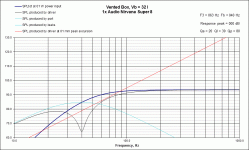 VB Response Audio Nirvana Super 8.gif33.4 KB · Views: 450
VB Response Audio Nirvana Super 8.gif33.4 KB · Views: 450 -
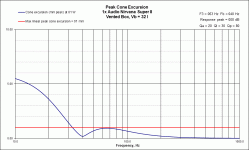 VB Excursion Audio Nirvana Super 8.gif21.4 KB · Views: 459
VB Excursion Audio Nirvana Super 8.gif21.4 KB · Views: 459 -
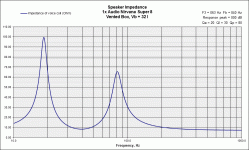 VB Impedance Audio Nirvana Super 8.gif35.4 KB · Views: 438
VB Impedance Audio Nirvana Super 8.gif35.4 KB · Views: 438 -
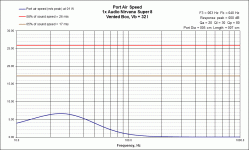 VB PortAirSpeed Audio Nirvana Super 8.gif23.7 KB · Views: 435
VB PortAirSpeed Audio Nirvana Super 8.gif23.7 KB · Views: 435 -
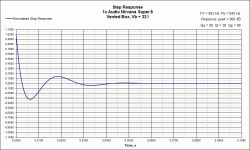 VB Step Response Audio Nirvana Super 8.gif26.8 KB · Views: 437
VB Step Response Audio Nirvana Super 8.gif26.8 KB · Views: 437
The Super 8 and 'bass' are two terms that sit rather uneasily together; irrespective of the claims on the CSA site, these drivers as-is, from the advertised spec., are not ideal for reflex loading if you want much in the way of LF extension since they are not exempt from the laws of physics.
If you're running a voltage source, try 16 litres tuned to 58Hz. It won't have any LF, but at least it'll be well behaved. Unless rammed up against a front-wall or in corners & heavily toed in, you will almost certainly need a shelving filter to compensate for step-loss.
If you're running a high output impedance amplifier then you may get a bit more out of them; likewise if you're willing to sacrifice some sensitivity by putting some series R in place. For e.g., 4ohms series R would make something like 32 litres tuned to 40Hz useable.
Thank you for the detailed message but all this is above my head. If someone could just give me some cabinet dimensions to use. I know that is lame but that's where I am at now. Thanks
You aren't able to draw a box of 16 litres or 32 litres volume?
16 litres: internal HxWxD = 12.375in x 9in x 9in. Line top, back & 1 sidewall with damping material; Ultratouch, 1in acoustic fibreglass for hi-vac ducts or similar. Avoid egg-crate foam. Driver centre mounted 5in down from internal top. Vent = 2in diameter x 2.875in long, total. Rear-firing, vent-centre 3in up from internal bottom on the rear baffle. It will have almost no real bass, but assuming the AN driver specs. are accurate (just assuming), it will at least be well behaved.
32litres: internal HxWxD 18in x 9in x 12.75in. Line box as above. Driver centre 6in down from internal top. Vent = 2in diameter x 3in long, vent centre 6in up on internal rear panel. If you're running a voltage source (regular solid state) amplifier, insert a 4ohm resistor of suitable rating in the positive lead to the driver.
Both of these boxes are oversized to account for the volume taken up by the driver itself, the vent & any internal bracing you may feel inclined to add. You will likely wish to adjust the internal damping quantities to suit, and you will likely need a shelving filter to help with step loss unless they are close to a front wall or in corners.
16 litres: internal HxWxD = 12.375in x 9in x 9in. Line top, back & 1 sidewall with damping material; Ultratouch, 1in acoustic fibreglass for hi-vac ducts or similar. Avoid egg-crate foam. Driver centre mounted 5in down from internal top. Vent = 2in diameter x 2.875in long, total. Rear-firing, vent-centre 3in up from internal bottom on the rear baffle. It will have almost no real bass, but assuming the AN driver specs. are accurate (just assuming), it will at least be well behaved.
32litres: internal HxWxD 18in x 9in x 12.75in. Line box as above. Driver centre 6in down from internal top. Vent = 2in diameter x 3in long, vent centre 6in up on internal rear panel. If you're running a voltage source (regular solid state) amplifier, insert a 4ohm resistor of suitable rating in the positive lead to the driver.
Both of these boxes are oversized to account for the volume taken up by the driver itself, the vent & any internal bracing you may feel inclined to add. You will likely wish to adjust the internal damping quantities to suit, and you will likely need a shelving filter to help with step loss unless they are close to a front wall or in corners.
Last edited:
Lowther DX Series of Drivers in a ML TL Enclosure
Hi,
Just copy the boxes and most of the options given
in the above article. The AN driver is a a Lowther
equivalent and the above article is as much
common sense as you are likely to find.
rgds, sreten.
http://www.quarter-wave.com/Project04/ML_TL_Plans.pdf

Hi,
Just copy the boxes and most of the options given
in the above article. The AN driver is a a Lowther
equivalent and the above article is as much
common sense as you are likely to find.
rgds, sreten.
http://www.quarter-wave.com/Project04/ML_TL_Plans.pdf

.... are not ideal for reflex loading if you want much in the way of LF extension since they are not exempt from the laws of physics.
The consequence of going for such hi-efficiency is this size driver. Hoffmann's Iron Law.
dave
Lowther DX Series of Drivers in a ML TL Enclosure
Hi,
Just copy the boxes and most of the options given
in the above article. The AN driver is a a Lowther
equivalent and the above article is as much
common sense as you are likely to find.
rgds, sreten.
http://www.quarter-wave.com/Project04/ML_TL_Plans.pdf

Do you feel like these speakers give you good bass?
Depends who you ask. The primary issue is that if you want bass from a simple, relatively small box, it's not really an ideal driver unless you apply some Eq (active or passive), or have a high output impedance amplifier, since it has a very low Q. That in itself is not necessarily a bad thing, but it does mean it has a highly damped LF.
Last edited:
Yes, it does matter whom you ask. If you ask Nelson Pass, he'll tell you to go for it. They're a lot of fun for the amount of outlay.
If you are expecting thundering bass then you picked the wrong driver. You would need large back horns to get bass from these drivers. Check out Nelson's Kleinhorns:
https://www.passdiy.com/project/speakers
But other than bass, these are some of the best value drivers of the high-efficiency full range driver types out there. I had them in folded voight pipes and with some shelving and notch filters they sounded pretty good. I can send you plans if you'd like. Send PM.
If you are expecting thundering bass then you picked the wrong driver. You would need large back horns to get bass from these drivers. Check out Nelson's Kleinhorns:
https://www.passdiy.com/project/speakers
But other than bass, these are some of the best value drivers of the high-efficiency full range driver types out there. I had them in folded voight pipes and with some shelving and notch filters they sounded pretty good. I can send you plans if you'd like. Send PM.
Thank you for the detailed message but all this is above my head. If someone could just give me some cabinet dimensions to use. I know that is lame but that's where I am at now. Thanks
OK, build to your floor standing specs, position the driver down ~12.625” and the 3” dia. x 2” long vent down ~27.5” from the top [inside]; line the top, one side and back with insulation using whatever your preference till it sounds good to you. The sim's smoothing based on lining with felt, rigid polyfil sheet or similar.
Note that based on a ‘worst case’ set of specs [attached] from published and measured [2], the vent length assumes a real world Fs closer to the 49 Hz it's tuned to than the published 37 Hz.
Due to the driver’s extreme HF ‘shout’, toeing them in to cross somewhat in front of the ‘sweet spot’ to flatten this out is the preferred way if no [super] tweeter is used.
Experimenting with a 4-8 ohm wire wound, non-inductive power resistor in series with the speakers will tilt the response down to give them more perceived bass.
If you can go 11.25" x 10.75" [acoustically the same size internally], then you can build it out of 1x10 and 1x12 x 0.75” board stock to keep construction effort down and due to its diminutive size, no need for bracing except for mass loading the driver off the rear wall.
Sims are with a 4 ohm resistor Vs 0.5 ohm [wiring losses] in series to show the relative difference in tonal balance [perceived bass] it makes.
GM
Attachments
I am kind of getting the feeling that the AN Super 8's are not well received. Am I right? Be brutal because I don't want to invest in making cabinets if they are not good quality....
Like other high efficiency / full range drivers they are not known for their bass.
That said, every time I've listened to mine I decided that they sounded better
than they had a right to.
- Status
- This old topic is closed. If you want to reopen this topic, contact a moderator using the "Report Post" button.
- Home
- Loudspeakers
- Full Range
- First Experience Hi Efficiency Speakers
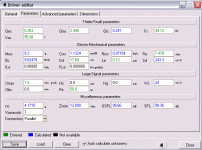
![Audio Nirvana Super 8 MLTL [dklk] 4 ohms series resistance.gif](/community/data/attachments/336/336534-0317367271e65c3514ca5dc543b0ae30.jpg)
![Audio Nirvana Super 8 MLTL [dklk] 0.5 ohms series resistance.gif](/community/data/attachments/336/336538-23d25ee67c10447e66168bf86d877da6.jpg)